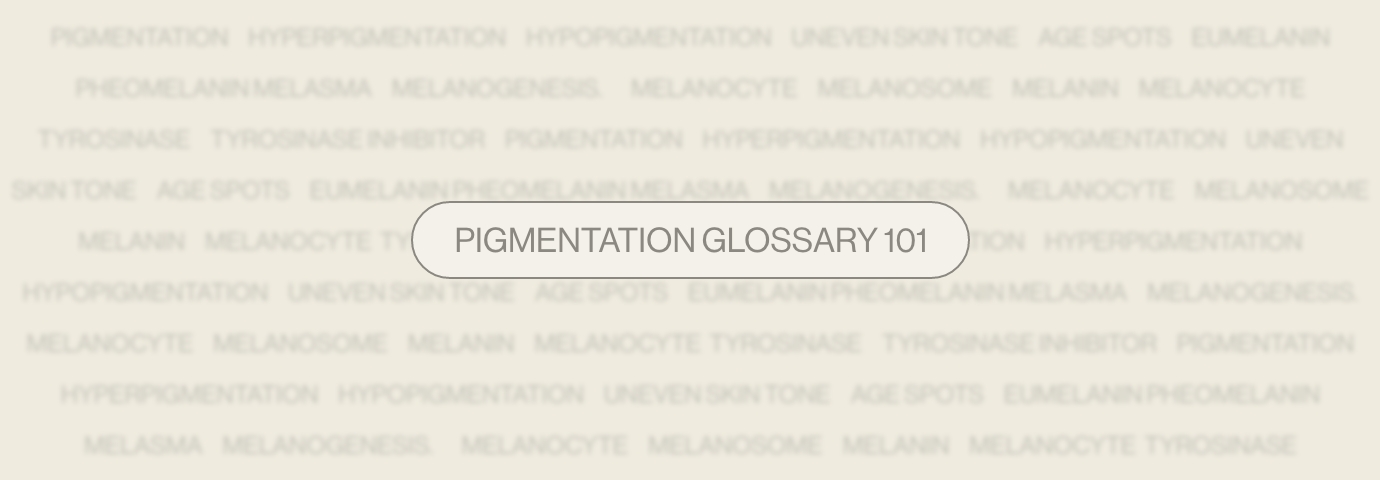Pigmentation 101: a definition of the terms you need to know

You may well have heard the term ‘pigmentation’ or ‘hyperpigmentation’ banded around, or even noticed darker patches of skin that point to this stubborn skin concern. But do you know your melasma from your melanin? Let’s look into the most common terminology used when describing pigmentation, and crucially – what they all mean.
Pigmentation
This is the most common term used and is a blanket term that can encapsulate both hypopigmentation and hyperpigmentation (which we’ll cover below). Essentially, pigmentation is a process that determines the colour of our skin, hair and eyes. It’s controlled by specialised cells called melanocytes, which are found in the basal layer of the skin's epidermis. These cells produce a pigment called melanin, which is what gives our skin its skin tone. Problems occur when the process becomes unbalanced – producing too much pigmentation (hyperpigmentation) or too little (hypopigmentation).

Hyperpigmentation
Hyperpigmentation can be spotted when the skin is discoloured. The most common types of this are age spots, sunspots – oval areas of increased pigmentation and post-inflammatory hyperpigmentation (PIH), which is the discolouration and redness left from problem skin.
Hypopigmentation
Similar to hyperpigmentation, this skin concern can be spotted with abnormal areas of discolouration. This time around, however, the areas are lighter – as the cells are unable to make enough of the pigment called melanin. Hypopigmentation can manifest as vitiligo.
Uneven Skin Tone
Uneven skin tone can be in many different forms. This may consist of redness, age spots, or sun damage, which can cause patches of colour on the skin. Uneven skin tone is generally considered to be hyperpigmentation – which leads to the formation of flat brown spots or patches that are darker in comparison to your overall complexion.
Age Spots
Also known as liver spots, age spots are small dark patches which often show up in places that get lots of sun, like your face, hands, shoulders, and arms. Age spots are common in those aged 50 years and over but can also show in younger individuals who have spent extended periods of time in the sun.
Melasma
Melasma is a common skin disorder with brown or grey discoloured patch of skin on the face exposed to the sun. Melasma can affect anyone but is most common in women who have darker complexions and can also be associated with female hormones including during pregnancy and women using birth control pills. Because of this, is it often called ‘the pregnancy mask’.
Melanocyte
Melanocytes are specialised cells found in the skin, hair follicles and eyes. They are responsible for a pigment called melanin. Think of melanocytes as tiny factories within our bodies that produce melanin. When melanocytes are exposed to sunlight, they produce more melanin to help protect our skin. When this process is overactive, this leads to hyperpigmentation.
Melanosome
A melanosome is a tiny structure found inside melanocytes, the specialised cells that produce melanin. Think of a melanosome as a package within the melanocyte. The melanosome’s main job is to store and transport melanin. It acts like a tiny warehouse for melanin storage. When melanocytes are stimulated by sunlight or blue light the melanocytes produce melanin and package it into melanosomes.
Melanin
This is a broad term for a group of natural pigments found in the body and is produced by Melanocytes. The more melanin you produce, the darker your eyes, hair and skin will be. The amount of melanin in your body depends on a few different factors, the main one being genetics.

Tyrosinase
This is an enzyme that plays a key role in the production of melanin. It is primarily found in melanocytes, which are responsible for producing melanin. Its main job is to trigger a series of chemical reactions that convert the amino acid tyrosine into melanin.
Tyrosinase Inhibitor
This is a substance or compound that inhibits the activity of the enzyme called tyrosinase. By slowing down tyrosinase activity, you can slow down the production of melanin. These inhibitors are commonly used in cosmetic and skincare products and more recently in food supplements.
Eumelanin
This is the brown to black pigment that is one of the most common forms of pigment.
Pheomelanin
This is the reddish, yellow pigment that is another common form of pigment.
